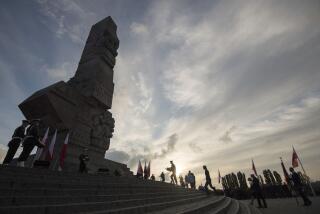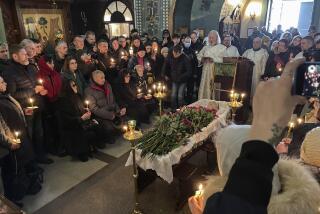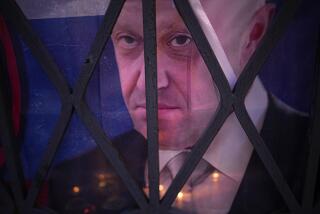Last Survivor of Stalin Clique Cremated : Communists: Final rites for Kaganovich are held at the site where bodies of victims of purges he helped engineer were burned.
MOSCOW — The last surviving henchman of Soviet dictator Josef V. Stalin was cremated Tuesday in the same crematorium where the bodies of thousands--if not millions--of victims of the purges he helped engineer were burned to eternally wipe away their identities.
Lazar M. Kaganovich, an ardent Communist until the end of his life, died last week at the age of 97, in a period when the Soviet Union has been readopting many of the capitalist practices that Kaganovich and the rest of Stalin’s inner circle tried to destroy forever with their reign of terror.
A couple of hundred people--many of whom still profess their love for Stalin and Kaganovich--gathered to pay their last respects to the man who assisted in carrying out the mass collectivization campaigns of the 1930s that resulted in the deaths of millions of people.
“Today we are burying Stalin’s last comrade--he’s a man who never changed his convictions,” Kira A. Kornienkova, 55, a geography teacher, said just before Kaganovich’s coffin, draped in red cloth, was lifted from a red bus at Donskoi Crematorium. “He remained committed until the very end.”
Just because Stalin’s last close comrade has died, Kornienkova said, the West should not assume that Stalinism is dead, even if the American President is visiting this city to help the Soviet Union draw closer to the West.
“We will not let Bush kill off our socialist system,” added Kornienkova, who held red gladioli. “We will be firm about this. We need more people like Kaganovich, who worked not for his own interests, like our leaders today, but so that the people lived better.”
Although the majority of the people in the Soviet Union long ago rejected Stalin and all the atrocities that he and his underlings committed against their people, there are still a handful such as Kornienkova who remember the Stalinist period as the good old days.
As mourners pushed their way inside the crematorium to see the jowly Kaganovich for the last time, an old colleague, Vitaly Filimonov, delivered a eulogy in which he referred to Kaganovich as a student of V. I. Lenin, the leader of the Bolshevik Revolution, and a friend of Stalin.
No one who attended the short ceremony bothered to stroll through the graveyard next to the crematorium, where a stone marked “General Grave, Unclaimed Ashes, 1930-1942” stands as the only memorial to thousands of victims of purges--such as those organized by Kaganovich--whose remains are buried there.
According to historian Roy Medvedev, Kaganovich, as Stalin’s key assistant, played a “sinister role” in the forced collectivization of private farms as well as the political purges of 1937-1938.
As early as 1932, Kaganovich helped wage ruthless terror in the northern Caucasus and helped conduct the mass deportations of the residents of large Cossack villages.
And former Soviet leader Nikita S. Khrushchev, who was a protege of Kaganovich, described him in his memoirs as one of the most “vicious” of all Bolsheviks.
But the mourners gathered at Donskoi remembered him for other deeds. Several had worked under Kaganovich in the construction of the Moscow subway system, which was originally named after him.
Some remembered his coming down to the tunnels dressed in worker’s clothing and expressing concern about their job conditions.
“He always worked for the sake of the Soviet power,” said Fyodor I. Semikin, 86. “He’s the third-greatest figure after Stalin and (former Foreign Minister Vyacheslav M.) Molotov.”
Semikin defended the purges as an evil that was unavoidable in order for the country to build socialism.
“What he did was normal,” Semikin said, “because there was a great battle under way.”
Kaganovich’s nephew, Leonid M. Kaganovich, said he understands that his uncle is a very “controversial” figure, but he cautioned that people should not judge him by today’s standards.
“You need to consider the times,” the nephew said.
More to Read
Sign up for Essential California
The most important California stories and recommendations in your inbox every morning.
You may occasionally receive promotional content from the Los Angeles Times.










